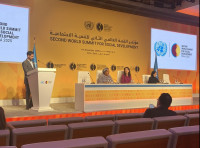Opinion
The saffron and the black
Religion in South Asia is understood as a ritualistic exercise, rather than an ethical search for meaning
Pramod Mishra
I’m writing this column on the 124th birth anniversary of BR Ambedkar, the chief draftsman of India’s constitution, and more importantly, the torchbearer of India’s ‘untouchables’, or Dalits. At a time when Nepal’s second Jananadolan movement has officially ushered in secularism through the Interim Constitution and will enshrine secular, republican values in the new constitution, religion seems to have receded into the background, at least in official lingo. But not so fast.
Open and closeted Hinduwad
Nepali Dalits, both in the hills and the plains, remain an oppressed community. Wherever a Dalit and a non-Dalit get married by choice, they not only find themselves excommunicated by the non-Dalit community but also feel all kinds of pressure, including actual violence, to separate. Just last week, we learned that the Inspector General of the Nepal Police Upendra Kant Aryal had a well dug in his village that every community, other than Dalits, were allowed to use. When such an event takes place in the village of Nepal’s chief of police, one can just imagine what goes on in places where the long arm of the law falls short.
And, then, we have the open and political Hindutva champions, such as Kamal Thapa and his followers, and the closeted, cultural Hinduwadis, such as Modnath Prashit, the Bahun ideologue of the harmless left, who have found themselves orphaned in power politics in the absence of the Hindu monarchy and Nepal’s official designation as a Hindu state. While Nepal’s secular and republican dispensation remained anathema to the open and political Hinduwadis, the cultural and closeted Hinduwadis came to realise a bit late that without the twin power centres—crown as a source of political power and official designation of the state as Hindu as a source of cultural power—they, too, had lost their ready-made, already-given status of super citizens. Appeal to Hindu nationalism seems to be the only way they can not only unite the hill castes but also bring under the electoral umbrella upper and middle-caste Madhesis, thereby salvaging power for themselves.
So far, the analytic landscape appears clear. Each group is trying its best to gain new, or regain old, political and cultural power. But what is not clear is what to do with the continued overt and covert, blatant or ideological violation of Dalits’ basic human rights? One can clearly understand that Kamal Thapa and his followers may not have any interest in either speaking against or doing anything about Dalit oppression because they come from Nepal’s Sanatani Rana-Shah Hindu culture, where women become untouchable during menstruation and live subservient lives, and save for Bahuns and Chhetris, everyone else is the inferior ‘other’.
An eventual realisation
But what about closeted, cultural Hinduwadis? When everything was going well for them in the old dispensation, they wanted political freedom and presented themselves as democratic and liberal, knowledgeable as they were not only of their own scriptures but also of books available to them in English. Now that the traditional power structure is sliding unexpectedly away from them, they are in panic. They clamour against the real and phantom Christian proselytisers but do nothing, say almost nothing, against Hinduism’s caste oppression against Dalits and animists.
And the education system ignores the issue totally. Lack of informed and critical public discourse, systematic study, and critical thinking about religion in school, college, and university has made religion, especially Hinduism, a dark tunnel where only the Brahmin, educated in Sanskrit schools and colleges, can navigate with his eyes closed and tongue chanting Sanskrit verses.
This realisation came to me in my village in Morang on the Nepali New Year’s day in 1997. My father had died the previous day. After the funeral, I felt an existential void; I struggled to grasp the meaning of this loss of someone who had been the bulwark of my survival and worldview. All his life, he had taken villagers from the hills and plains for spiritual cleansing to Hindu holy places and for physical cures to healthcare facilities in the four corners of India. So, I asked for Sukhsagar, a compilation of narratives around King Pariskshit and Sukdev the sage from the Bhagwat Puran. Sukhsagar had rescued me from deep depression and despair when I was seven years old. It had been my Grimm’s and Hans Christian Anderson fairy tales, nurturing my imagination and inspiring me to find meaning in literature and philosophy. Then, in 1997, I wanted it to do the same—come to my aid in confronting this void.
As I began reading the text, I felt appalled. Every other page referred to ‘shudras’ in a derogatory manner. Soon, I gave up. How was it that I hadn’t noticed this in my childhood? How was it that the press that printed the scriptures churned out thousands of years’ old texts, that every Hindu either reads or listens to, without critical commentary on their flaws and merits?
Religion as a secular subject
The answer lies in the uncritical nature of India’s educational system that Nepal has blindly copied. How was it that Ambedkar, discriminated and mistreated since his childhood in Maharastra, came to critically theorise Hinduism’s flaws in a way that not even other caste rebels, such as Periyar, were able to do? It was because Ambedkar had studied at Columbia University, where college and university curriculum included not only religion but its critical analyses in class discussion, essay writing, and presentation. Almost all colleges and universities in the United States have religion as a secular subject in the undergraduate curriculum. Many private universities have full-fledged divinity schools. As a result, a college-educated person comes to acquire a complex picture of religion, including Christianity.
In the Nepali and Indian college curriculum, on the other hand, both the form and content of religion are missing, making religion an esoteric subject reserved only for Brahmin priests or political adventurers. Consequently, an educated person in South Asia knows his or her religion as a simplistic, ritualistic, received exercise of faith, rather than a vibrant, intellectual, ethical, and philosophical search for meaning in the world. This uncritical acceptance of Hinduism is its greatest enemy—and a great loss for Hindus themselves.




 14.12°C Kathmandu
14.12°C Kathmandu










